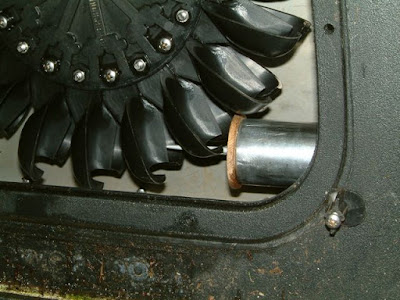After 10 days, the ceramic bearings I reported in my last post are doing OK and it has been possible to revise upward the measurement of power gained by them from 9 to 10 watts, ie 0.24 kWh per day.
The whole question of how much power is lost in the rotating parts of my turbine has been something I've been trying to understand better, and in this post I want to relate what I have found.
Before installing the ceramic bearings, I set about measuring the starting torque necessary to overcome friction in order for the bearings to start rotating. I did it by hanging a syringe filled with water on the splitter ridge of a pelton cup, increasing the amount of water until it was just sufficient to start the runner rotating. I then accurately weighed the filled syringe.
Having done this for the bearing block set up with ceramic bearings, I repeated it for three other types of bearing as follows:
- a block with standard SKF bearings fully greased which had not yet been installed
- a block the same as above which had done 7 months service
- a block with SKF E2 Energy Efficient bearings having only the grease put into them at manufacture but no grease in the block, and not yet run
...and finally
- a block with E2 bearings as above plus with the shaft seal fitted (the seal which prevents water tracking along the shaft toward the outer bearing)
Here are pictures of the last two of these measurements, ie E2 bearings, with and without the shaft seal:
 |
E2 bearings, no shaft seal:
20 ml syringe + 12 mls water,
total weight 28 grams |
 |
E2 bearings plus shaft seal:
60 ml syringe + 40 mls water,
total weight 78 grams |
From the above, it can be seen the shaft seal adds 50 grams weight to what is necessary to just start the runner rotating. Converting this to a torque: 50 g acting at 135 mm from the shaft centre is 66 N*mm (Newton millimetres).
It is now possible to work out how much shaft power is taken up in overcoming this frictional resistance. The formula is:
P (watts) = pi x T (Nm) x rpm / 30
and it works out at 6.9 W, or 0.165 kWh per day.
Now clearly the shaft seal is an absolutely "must have" item, - it cannot be dispensed with: the power loss associated with it is unavoidable. But for bearings, there are options to choose from and as has already been demonstrated, significant gains in power generated can be had by using ceramic bearings.
In the table below are the calculated values of power lost to friction, and energy lost per 24 hours, for each of the bearing combos investigated above. In each case, the calculation followed the same methodology as for the shaft seal:
I would want to stress that all of this is theoretical engineering, and also that I'm not an engineer or a mathematician, so don't go placing too much reliance on the absolute value of each figure. For one thing, the figures are based on a static test whereas in reality the situation is a dynamic one: the torque necessary to start a bearing rotating immediately diminishes as it begins to rotate but gradually increases again as speed of rotation picks up. This will mean that the starting torque used in the above calculations will not be the same as the frictional torque at 1000 rpm, - the operating speed of my turbine.
But nevertheless, the figures are relevant for their comparative value if not for their absolute accuracy. Particular points of interest include:
- how much friction there is after 7 months of running with a bearing block with standard SKF bearings. I had thought they would free up with use but the opposite seems to be the case.
- SKF E2 bearings appear to hold out the prospect of performing almost as well as ceramics, at least if the bearing housing is not greased and they are run as "greased for life" with just their factory grease. Since they are considerably cheaper than full ceramic bearings, this might be relevant, but they would still have the drawback of being susceptible to corrosion from the ingress of water in a way that ceramics are not.
As ever, maybe the future operation of my turbine can be used to provide more clarity about these matters. It'll be especially interesting to see how well these ceramic bearings last in the longer term.







